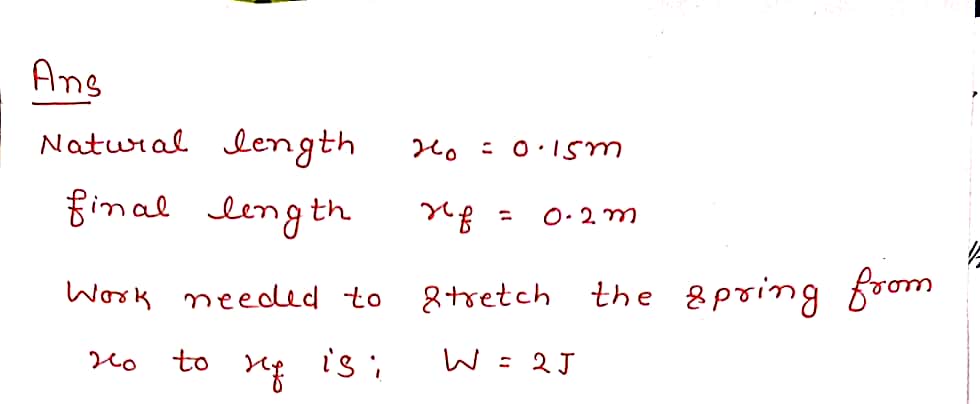(b) Suppose that 2 J of work is needed to stretch a spring from its natural length of 0.15 m to 0.2 m. How much work (in J) is needed to stretch the spring from 0.2 m to 0.3 m? (Round your answer to 2 decimal places.)
(b) Suppose that 2 J of work is needed to stretch a spring from its natural length of 0.15 m to 0.2 m. How much work (in J) is needed to stretch the spring from 0.2 m to 0.3 m? (Round your answer to 2 decimal places.)
College Physics
11th Edition
ISBN:9781305952300
Author:Raymond A. Serway, Chris Vuille
Publisher:Raymond A. Serway, Chris Vuille
Chapter1: Units, Trigonometry. And Vectors
Section: Chapter Questions
Problem 1CQ: Estimate the order of magnitude of the length, in meters, of each of the following; (a) a mouse, (b)...
Related questions
Question
![**Problem Statement:**
(b) Suppose that 2 J of work is needed to stretch a spring from its natural length of 0.15 m to 0.2 m. How much work (in J) is needed to stretch the spring from 0.2 m to 0.3 m? (Round your answer to 2 decimal places.)
**Explanation:**
This question involves calculating the work done in stretching a spring, which is governed by Hooke’s Law. The work done in stretching or compressing a spring is given by the integral of the force function over the distance stretched or compressed.
1. **Understanding Hooke’s Law:**
- The force required to stretch or compress a spring by a distance \( x \) (from its natural length) is given by \( F(x) = kx \), where \( k \) is the spring constant.
2. **Calculating Work:**
- Work done on the spring can be calculated using the formula: \[ W = \int_{a}^{b} F(x) \, dx = \int_{a}^{b} kx \, dx \]
- From 0.15 m to 0.2 m, the given work is 2 J, which can be used to find the spring constant \( k \).
3. **Steps to Solve:**
- Determine \( k \) using the known work done from 0.15 m to 0.2 m.
- Use the same \( k \) to calculate the work needed from 0.2 m to 0.3 m.
4. **Instructions for Solution:**
- Ensure the integration limits correspond to the stretch distances in the question.
- Perform the integration to find the total work done.
- Ensure calculations are precise and round off the final result to two decimal places for accuracy.
This methodology aids in understanding the physics behind spring force and energy concepts in a practical context.](/v2/_next/image?url=https%3A%2F%2Fcontent.bartleby.com%2Fqna-images%2Fquestion%2F11b54239-8e64-41df-bbac-e376c02f6bfa%2F8ec7972d-98c6-4fc1-bc1e-0badd2cc9d9f%2Fum1oqz_processed.png&w=3840&q=75)
Transcribed Image Text:**Problem Statement:**
(b) Suppose that 2 J of work is needed to stretch a spring from its natural length of 0.15 m to 0.2 m. How much work (in J) is needed to stretch the spring from 0.2 m to 0.3 m? (Round your answer to 2 decimal places.)
**Explanation:**
This question involves calculating the work done in stretching a spring, which is governed by Hooke’s Law. The work done in stretching or compressing a spring is given by the integral of the force function over the distance stretched or compressed.
1. **Understanding Hooke’s Law:**
- The force required to stretch or compress a spring by a distance \( x \) (from its natural length) is given by \( F(x) = kx \), where \( k \) is the spring constant.
2. **Calculating Work:**
- Work done on the spring can be calculated using the formula: \[ W = \int_{a}^{b} F(x) \, dx = \int_{a}^{b} kx \, dx \]
- From 0.15 m to 0.2 m, the given work is 2 J, which can be used to find the spring constant \( k \).
3. **Steps to Solve:**
- Determine \( k \) using the known work done from 0.15 m to 0.2 m.
- Use the same \( k \) to calculate the work needed from 0.2 m to 0.3 m.
4. **Instructions for Solution:**
- Ensure the integration limits correspond to the stretch distances in the question.
- Perform the integration to find the total work done.
- Ensure calculations are precise and round off the final result to two decimal places for accuracy.
This methodology aids in understanding the physics behind spring force and energy concepts in a practical context.
Expert Solution
Step 1

Step by step
Solved in 3 steps with 3 images

Recommended textbooks for you

College Physics
Physics
ISBN:
9781305952300
Author:
Raymond A. Serway, Chris Vuille
Publisher:
Cengage Learning

University Physics (14th Edition)
Physics
ISBN:
9780133969290
Author:
Hugh D. Young, Roger A. Freedman
Publisher:
PEARSON

Introduction To Quantum Mechanics
Physics
ISBN:
9781107189638
Author:
Griffiths, David J., Schroeter, Darrell F.
Publisher:
Cambridge University Press

College Physics
Physics
ISBN:
9781305952300
Author:
Raymond A. Serway, Chris Vuille
Publisher:
Cengage Learning

University Physics (14th Edition)
Physics
ISBN:
9780133969290
Author:
Hugh D. Young, Roger A. Freedman
Publisher:
PEARSON

Introduction To Quantum Mechanics
Physics
ISBN:
9781107189638
Author:
Griffiths, David J., Schroeter, Darrell F.
Publisher:
Cambridge University Press

Physics for Scientists and Engineers
Physics
ISBN:
9781337553278
Author:
Raymond A. Serway, John W. Jewett
Publisher:
Cengage Learning

Lecture- Tutorials for Introductory Astronomy
Physics
ISBN:
9780321820464
Author:
Edward E. Prather, Tim P. Slater, Jeff P. Adams, Gina Brissenden
Publisher:
Addison-Wesley

College Physics: A Strategic Approach (4th Editio…
Physics
ISBN:
9780134609034
Author:
Randall D. Knight (Professor Emeritus), Brian Jones, Stuart Field
Publisher:
PEARSON